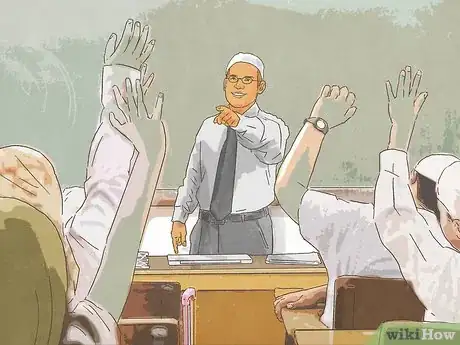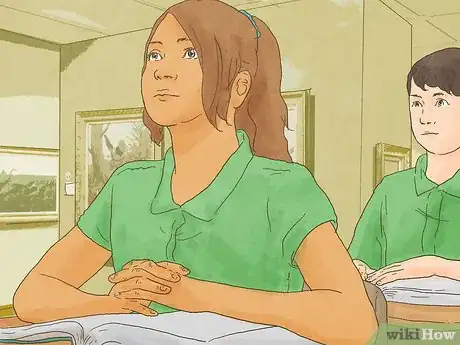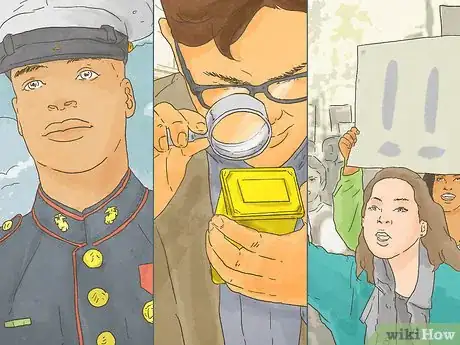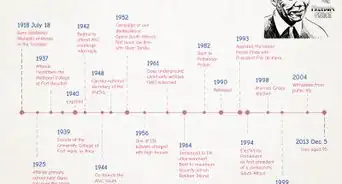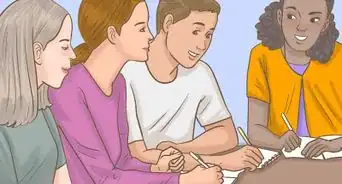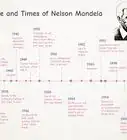This article was co-authored by Emily Listmann, MA and by wikiHow staff writer, Jessica Gibson. Emily Listmann is a private tutor in San Carlos, California. She has worked as a Social Studies Teacher, Curriculum Coordinator, and an SAT Prep Teacher. She received her MA in Education from the Stanford Graduate School of Education in 2014.
There are 8 references cited in this article, which can be found at the bottom of the page.
This article has been viewed 22,404 times.
All Americans have taken some American history class at some point. Elementary school children are usually taught American history as part of a social studies course, while older students can take specific history or American history classes. Regardless of what age you're teaching, it can be difficult to cover the breadth of American history in one term or school year. To include everything you'd like to teach, it's important to develop a teaching style, construct your course, and create an interactive classroom environment to help your students learn.
Steps
Developing Your Teaching Style and Skills
-
1Determine the scope of your course. Before you set out to build a course on American history, take time to decide how much ground you can cover. Are you doing a broad survey course that covers American history from prehistoric times to the present day, or will your course focus on a narrower time period (e.g., Pre-Columbian America during the Woodland period, the American Revolution, or the Civil War)?
- This is also a good time to consider your thematic approach. For example, do you plan to organize your course around one or more major historical events, or would you rather focus on themes, such as economic or military history?
-
2Make a list of skills you want your students to learn. Teaching history is about more than just making sure your students learn the content. As a history teacher, take time to think about ways that you can encourage your students to develop the kinds of skills that professional historians use. For example, you might wish to focus on teaching your students how to:
- Do critical readings of primary source documents.
- Use academic research resources and databases, such as EBSCO and JSTOR.
- Write argumentative essays or participate in debates about controversial historical topics.
Advertisement -
3Offer clear expectations for the course. If you're teaching older students, create a course syllabus. The syllabus should list the grading scale, historical events or themes covered in the course, course expectations, all readings, and assignments (which should include a mix of essays, exams, and discussion groups). If you're teaching younger students, you don't need to give them a syllabus—just make the important points of the lessons clear.
- For example, your young students should be able to understand why the 4th of July is important if you're teaching the American Revolution.
- Make sure that you include any school requirements in your course (like standardized testing or academic writing).
-
4Give your students constructive feedback. In courses where students only have one exam and one writing assignment, it may be hard for them to gauge how they're doing academically. Try to assign a variety of smaller assignments so you can see how your students are doing. Spend some time writing details of how they can improve, especially if it's early in the term. You might try assigning short answer assignments in which your students write a few sentences to identify significant Americans or events in American history.
- You might assign short answer or identification questions at the end of every week. For example, you could have them explain the significance of the Boston Tea Party, the Stamp Act, and Federalists if you're covering the American Revolution.
- Try to return assignments promptly with your feedback so the students can make adjustments.
- Don't overwhelm the student with feedback. Make 2 or 3 suggestions for how they can improve.
-
5Assess your students’ learning. You can get a better idea of what your students are getting out of the course—and how to help them understand the material better—by making good use of assignments and assessments. When creating assignments, think about the essential questions you would like your students to answer about American history and what key understandings you would like them to take away from the course. For example, if you want your students to focus on critical analysis of primary sources:
- You might assign each student a different primary source document discussing a single historical event from a variety of perspectives.
- Have the students give presentations on their documents, and then sit down as a class and discuss the differences and contradictions between the documents.
- After the discussion, have the students write an essay about what these contradictions tell them about the reliability of their sources. How can they assess which sources are the most accurate or reliable? Why do the sources contradict each other? What can they learn about the biases or agendas of the people who wrote the documents?
- Assess the students’ answers to these questions. If they are still struggling to understand any key concepts, take more time to discuss those concepts as you move forward.
-
6Continue to learn about American history. It's easy to fall into a routine of teaching the same material year after year. To keep yourself and your students interested in American history, continue reading new articles or papers. Attend new exhibits or watch new documentaries that add to your knowledge about the subject.
- Your students may be more motivated to learn if you help them connect current events to historical events that you're teaching. For example, if there's an election coming up, you may want to talk to your students about how people have voted to change or amend the Constitution in the past. You could also compare historical elections to modern elections.[1]
-
7Socialize with other history teachers. If you're feeling overwhelmed, frustrated or bored by teaching American history, reach out to other history teachers. They may have experienced similar things in the past and have learned useful strategies. If you're one of the only history teachers at your school, consider attending a history conference or teaching workshop.
- Check with your school or institution to see if attending a conference or workshop earns you any professional development points.[2]
Developing an Interesting and Informative Course
-
1Adjust lessons according to the age of your students. If you're teaching American history to very young children, you'll probably want to cover the basics and teach using play. They'll enjoy watching a little show or listening to a picture book. If you're teaching students in middle school, consider taking them on a field trip (like to a museum or historical battlefield). Hands-on experiences can get the students excited about history. You can then assign a short review on what they learned.
- For older students, you can encourage them to think critically. Use a variety of teaching methods, assignments, and discussions to get them thinking about social, political, and economic implications of historical events.
- Plan mock debates where your students argue historical sides of an event (like women getting the vote or prohibition).
-
2Make history come alive through themes. Many students who complain they don't like history say they don't like just memorizing dates and names. Instead of making students feel as though history is completely factual, use themes or time periods and point out different ways of seeing the events. Each theme could include a variety of events throughout American history, not necessarily in chronological order.[3]
- Example themes include the discovery of America, the colonial era, American expansion, immigration, temperance reform, war, balance of power, the American Dream, and American identity.
- If you're teaching the American dream, you could discuss what the American dream means to your students, its basis in colonial history, and how it's changed throughout the 20th century. Have your students read Martin Luther King Jr.'s "I Have a Dream Speech" and discuss what the founding fathers would have thought of King's sentiments.
- Consider having students engage with primary source historical materials. For instance you can access Ellis Island immigration records, perhaps even researching students' ancestors.
-
3Create lesson plans. Write up a detailed lesson plan for each class period. You can work with other teachers or find examples of lesson plans through online national history sites. Your students won't need to see the lesson plans, but these plans will help you focus on important themes for the day, what readings you want to cover, and specific information you want to give to students (especially if it will appear on an exam).[4]
- Don't be afraid to change lesson plans as you go along. If you find yourself needing to take more time covering a topic, do so, but make a note so you can try to pick up at the next lesson.
- For example, one day you might note that your students need to have read a chapter in their textbooks, read a historical document, and be prepared to discuss the significance of a famous battle (if you're covering something like the Civil War).
-
4Use other disciplines to teach American history. You can do this for any level of history you teach. If you're teaching younger students, you're probably also teaching social studies (which may include geography and civics issues). If you're teaching older students, you can break up a standard lecture by including:[5]
- Music: Play music or popular songs from the time period you're teaching. For example, play jazz if you're teaching your students about the Harlem Renaissance.
- Art: Show your students paintings, sculptures and architecture from areas you're teaching. For example, you may want to show pop art and discuss how it reflected changing American mindsets after World War II.
- Science: Do experiments or discuss technological developments or inventions that were new to an era you're teaching. In a unit on postwar America, talk about how modern conveniences changed the American Dream.
- Literature: Have your students read excerpts from novels. Choose books that were popular, controversial, or written by influential people of the time period. Assign parts from Uncle Tom's Cabin and discuss how the book influenced perceptions of slavery.
- Films/plays: Show clips from movies or plays that represent what it might have been like to live during the time you're teaching. You can also discuss historical inaccuracies in the clips you watch. For example, you could watch scenes from "Gettysburg" or "Sons of Liberty."
Creating an Active Classroom Environment
-
1Schedule weekly discussions. If your students are old enough, schedule at least one class period a week for small group discussions. Earlier in the week, assign primary documents (like speeches, diaries, and government documents) or passages you want your students to read. Let them come up with questions and things to discuss. During discussions, have 1 or 2 students lead the group(s) so you don't end up taking over their discussion time.[6]
- If your students are too young to do traditional weekly discussions, try doing a gallery walk. Put up pictures of historical people, places, or themes you taught during the week. Let your young pupils walk around and talk about what they see and understand.
-
2Engage with your students during class time. Some students may struggle to find history interesting if you simply state facts and list names and dates. Your students might start tuning you out if you rely too much on lecturing. Instead, ask your students questions, get them to read out passages of documents, or break them into small groups to argue sides of a historical situation. Include visuals for those students who learn better by reading or viewing things.
- For example, you might start a lecture by asking students what they know about the day's topic. Let them know it's all right if they don't know much or are confused. You could also break up a lecture by asking how they think they would have reacted or behaved if placed in a similar situation.
- Keep lecturing to a minimum, if you can. Encourage your students to learn through hands-on activities, discussions, and collaborative projects.
- If you break the class into small groups to discuss documents or themes, be sure to walk around each group to see how they're doing or if they need help.
-
3Leave a few minutes for questions. If you've spent most of the period teaching and lecturing, save 5 to 10 minutes at the end of the class to answer student questions. If your students don't have any questions for you, ask them questions to ensure they understood the day's material. If they don't, you may need to go over some elements of the lecture again.[7]
- If you struggle to save time at the end of your lectures for questions, try offering pauses throughout the lecture where you ask if anyone has questions.
- You should also offer regular office hours. Tell your students what days and hours you're available for them to drop in and ask questions or get help. Remind students that they should come in for help throughout the term and not just right before big tests.
-
4Have guest speakers. It's nice to break up the classroom routine by inviting guest speakers to speak. A guest speaker can give a short talk about a historical theme or issue you're covering and can take questions from your students. This will also make you classroom more interactive. Good choices for guest speakers include:[8]
- War veterans
- Historians
- Librarians (even if they're only there to speak about how to research for an assignment)
- Political activists
- Museum curators
References
- ↑ http://www.spinedu.com/rethinking-engage-students-history/#.V54za7grLIU
- ↑ https://tickets.indianahistory.org/Info.aspx?EventID=85
- ↑ http://teachinghistory.org/nhec-blog/24585
- ↑ http://besthistorysites.net/lesson-plans/
- ↑ http://www.socstrpr.org/wp-content/uploads/2013/09/MS_06372_Spring2013.pdf
- ↑ http://www.cultofpedagogy.com/speaking-listening-techniques/
- ↑ http://www.hist.cam.ac.uk/undergraduate/studying-history-at-cambridge-folder/faculty-teaching
- ↑ http://eprints.qut.edu.au/547/1/quanchi_teaching_booklet.PDF
